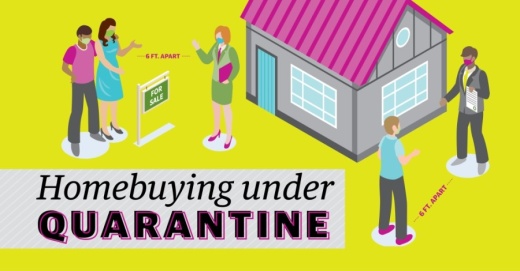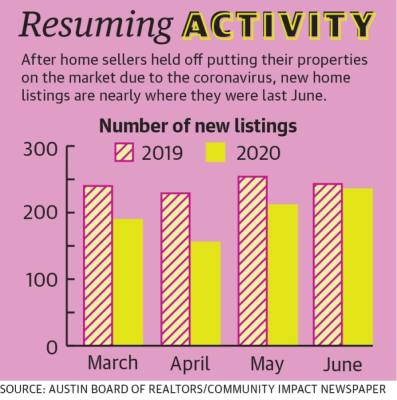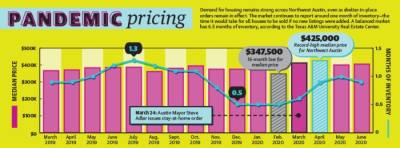Local real estate experts say the promising—albeit brief—uptick in some metrics signifies a recovering housing market.
“Austin is one of the best real estate markets in the country from a residential perspective. We’re well-positioned to come out of the [coronavirus] in pretty good shape,” said Vaike O’Grady, Austin regional director for real estate research and analytics firm Metrostudy.
While June’s market data returns show promising growth in rising home listings and sales, persistent real estate problems that existed prior to the pandemic are likely to continue, local experts said.
Northwest Austin’s notably small inventory of housing stock and shrinking supply of affordable entry-level houses are expected to continue throughout the end of quarantine.
“You didn’t have enough inventory going into this, and you don’t have enough going out of this,” said Mark Sprague, state director of information capital at Independence Title. “You don’t have enough apartments. You don’t have enough homes. It will continue to be a challenge.”
Homes hit the market again
Across Northwest Austin, housing inventory—the amount of time it would take for all remaining homes on the market to sell if no new homes were built—remains below what is considered normal for a healthy market.
In June, for the eighth straight month, the market had one month or less of inventory, according to Austin Board of Realtors data. For comparison, the Texas A&M University Real Estate Center considers a balanced real estate market to have 6.5 months of inventory.
Northwest Austin’s housing inventory problem existed months before the first case of coronavirus was confirmed in Austin in March, but the pandemic has kept owners from listing their homes.
“There is still hesitation to put homes on the market because of health concerns,” ABoR President Romeo Manzanilla said. “Some sellers are holding off because they feel they just can’t find a home.”
New home listings in Northwest Austin have seemingly recovered in June. ABoR reported 235 new listings were posted in the month, compared to 243 in June 2019.
That bucked a three-month trend of slumping new home listings in the market. From March to May, ABoR reported 555 new listings in the six ZIP codes in Community Impact Newspaper’s Northwest Austin distribution area. That represented a 23.23% decrease from the same three-month window in 2019.
In a similar trend, closed home sales across the market have been falling since citywide shelter-in-place orders were imposed in March. The Northwest Austin market recorded a collective 44.07% year-over-year decrease in closed home sales through April and May. The market seemed to rebound, comparatively, in June, when home sales saw a 12.85% year-over-year decline.
“If you look at it from a development standpoint, you have a lot of growth over the last several years in the Northwest Austin area. It still is one of the parts of the city that is pretty stable when you look at the turnover in terms of how long people stay,” Manzanilla said.
Buyer demand remains strong
The same factors that keep Northwest Austin residents in their homes continue to draw prospective buyers into the market, even during a global health crisis.
“For being close proximity to entertainment, good schools and shopping, Northwest Austin has a lot to offer,” Manzanilla said.
That demand has kept Northwest Austin’s rising median home price stable throughout turmoil. The marketwide median price in June stood at $405,000—just $5,000 under the median price for all residential properties citywide.
Northwest Austin’s median price has sat above $400,000 since March, when the market hit that milestone for the first time ever.
Sprague said that demand for housing remains strong in Austin because the city’s underlying job growth remains strong, even as certain sectors—hospitality, leisure and retail—experience tremendous employment loss.
“Values continue to go up, and the reason they continue to go up is people continue to move [to Austin],” Sprague said.
According to the most recent data from the Texas Workforce Commission, most unemployment insurance claims in Travis and Williamson counties come from those employed in the restaurant and temporary help industries.
Meanwhile, job growth in Austin’s high-tech industry is outpacing most other industries. According to a July 7 report published by the Austin Chamber of Commerce, high-tech job opportunities in Austin grew by 7.7% in 2019, nearly double the rate of the Austin metro area’s overall 3.9% job growth rate. High-tech jobs account for 16.4% of all jobs in Austin, the report found.
It’s these types of tech workers, O’Grady contends, that drive the demand for housing. Northwest Austin, with proximity to Dell Technologies in Round Rock, Amazon and Indeed in The Domain, and the upcoming Apple Inc. campus under construction off West Parmer Lane, may be the most attractive submarket for incoming tech workers. Changing market trends
While local real estate experts agree the short amount of time the city has been under quarantine is too short a time to form concrete, long-term outlooks, some housing trends are beginning to emerge.
As homebuyers are looking at the ever-extending reality of working remotely from home, customers are beginning to look farther and farther for larger, more affordable homes.
“If people don’t have to commute to the physical work space then they are really looking to get the most bang for their buck. ... We’re going to see more of this urban sprawl into the suburbs,” Manzanilla said.
The growing trend of working from home may further lead homeowners to renovate their current properties to accommodate home offices. Prospective homebuyers and current homeowners may currently be driven to more space to include “Zoom rooms,” Sprague said, where one member of the family can isolate during work meetings.
“We’ll see a change in floor plans. ... Everybody is looking for a bigger home,” Sprague said.








